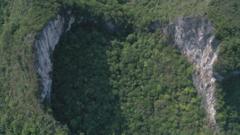The breathtaking sinkholes of Guangxi province, China, have morphed into a popular tourist destination, attracting individuals like Rui and Michael. However, while the allure of ancient forests and unique species captivates explorers, concerns rise regarding the potential harm to these delicate environments.
Sinkholes in Guangxi: A Dual-Edged Tourist Attraction

Sinkholes in Guangxi: A Dual-Edged Tourist Attraction
Ancient forests and fragile ecosystems are at risk as China's Guangxi sinkholes draw eager tourists seeking adventure.
Giant sinkholes in China's Guangxi province have captivated adventurous tourists, offering a glimpse into ancient forests and unique ecosystems below. These deep formations, known as “tiankeng” or "heavenly pit" in Mandarin, plunge over 100 meters (328ft) into a verdant realm alive with the sounds of cicadas and birds. For centuries, locals feared these mysterious chasms, shrouded in mist and mysticism, likely due to tales of lurking demons. However, drones and intrepid explorers, including those who first trekked into these geological wonders, have unveiled the sinkholes’ secrets, transforming these natural formations into a burgeoning tourist hotspot.
China boasts two-thirds of the world's more than 300 sinkholes, with Guangxi harboring the highest concentration, including its most recent discovery—a 40-meter-tall ancestral forest. The ecological riches held within these hollowed spaces are both astonishing and precarious. With increasing tourist footfall, scientists worry that fragile ecosystems could be jeopardized.
For tourists like Rui and Michael, the experience promises both thrill and connection to the unknown. “I’ve never done this kind of thing before,” Rui admits, brimming with excitement as she prepares to rappel into the depths. Her guide, Brother Fei, reflects on the shift from trepidation to awe that the sinkholes inspire, having once believed that venturing into the depths could invite wrath from spirits. Yet now, he serves as a knowledgeable connector, sharing the wonders of Guangxi's sinkholes with eager visitors.
Scientific exploration has revealed extraordinary biodiversity within these sinkholes, including previously unrecorded plant and animal species. These unfamiliar ecosystems, preserved over thousands of years, are not only critical to understanding biodiversity but also for examining Earth’s historical shifts and the consequences of climate change. Still, the clash between tourism and the preservation of these natural habitats raises alarms among researchers like Dr. Lina Shen, who stress the importance of maintaining the sinkholes' ecological integrity.
As tourism thrives, locals in Ping'e village experience a boost in their fortunes, renewed by the promise of economic growth. Yet, the increased visibility of the sinkholes begs the question: how do we balance the dual edges of exploration and preservation? Innovative strategies, from aerial views to regulated access, could help protect these vibrant ecosystems while still allowing for public engagement.
In the shadows of limestone cliffs and lush, ancient forests, tourists like Rui and Michael navigate their way deeper into this otherworldly environment, reflecting on the thrill of their exploration. The challenge, as Fei emphasizes, lies in striking a balance between enjoyment and ecological stewardship—ensuring that these magnificent sinkholes continue to be both a source of natural wonder and a sanctuary for rare species.





















